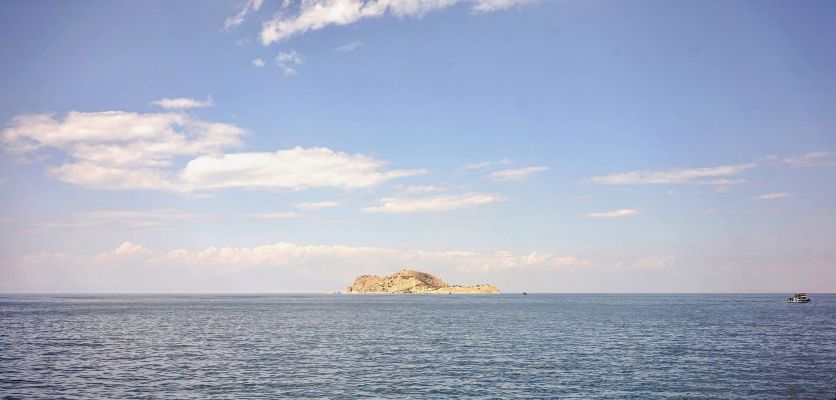'Akh, Tamar!': A photo story
September 06, 2019
Every night, a beautiful Armenian maiden named Tamar would wave a light from Akhtamar Island’s shore in the direction of her lover, who would then swim to her from the mainland to reunite in silence. But Tamar was a princess and the boy, a commoner. When her father found out about their secret meetings, his anger got the best of him. As Tamar was lighting her lover’s way, her father approached her and blew out the light. Without a glow to guide him across Lake Van, the boy drowned in the darkness of the night, wailing, “Akh, Tamar!” (“Oh, Tamar!”).
In Sept. 2018, a friend and I hopped on a boat and set off across the lake for the island of Akhtamar in Western Armenia—a geographical area, which was renamed "Eastern Anatolia" after the Armenian Genocide of 1915. As we were getting closer to the very same location where this legend is said to have taken place to attend a liturgical service in the Church of the Holy Cross (Surb Khatch in Armenian) organized by the Armenian Patriarchate of Istanbul after a three year hiatus, I could not help but feel a warmth in my heart. Despite the long decades of silence imposed by the Turkish state in an active attempt to erase and censor the collective memories of the Armenians in their historic homeland, there we were, guided by the light again. We were about to visit a place of worship revered by many for being one of the most remarkable examples of medieval Armenian religious architecture and art; a place, which was built in the 10th century under the supervision of King Gagik I Artsruni of the Vaspurakan dynasty.
This year, the service is set to be held again in the Armenian Apostolic Church on the eighth of September. This will be the seventh service since 2010, when the Turkish state finally permitted for the Armenian divine liturgy to be held annually within its premises—also, the seventh since the genocide.
Moving through the water

Standing on the deck of the boat, we kept our eyes fixed on the island of Akhtamar in Lake Van—the largest lake in modern-day Turkey situated at an altitude of 1,640 meters—while singing traditional Armenian songs, the freezing wind sticking to our skin as we moved through the water.
Intricacy

Stepping off the boat, what struck me most as we got our first glimpse of the Church of the Holy Cross from up close was the wide array of intricate carvings and friezes of both religious and earthly scenes adorning its exterior walls.
Hymns unto God

The choir singing our ancestors’ enchanting hymns unto God, we entered the small sanctuary, which once served as the royal church to the Vaspurakan Kingdom. The room filled as the service began—mostly with Armenians from all corners of the world, Turkish officials, and a few curious tourists.
The light within

Soon, a bright light entered from one of the openings around the dome of the church built out of volcanic tuff stone between 915 and 921 by the architect and bishop Manuel. This added to the mystical atmosphere during the liturgy, while helping me connect deeper with the light within.
Awe and wonder

As much as I wanted to stay focused, I couldn’t help but gaze at the intricate frescoes decorating the interior walls, depicting biblical scenes from the story of creation and the life of Christ. Sublime works of art, which had stood the test of time, inspiring awe and wonder within me.
Unexpected interruption

As I was extending well wishes to all beings, the service was interrupted with the arrival of Turkish officials. The priest switched to Turkish and expressed his gratitude and belief in the greatness of Turkey, only to resume 30 minutes later with the preparation of the sacrament of Holy Communion.
Diving deeper

This episode unsettled me, making me wonder why, decades after the genocide, we, as a community, were still accepting such oppression. It also pushed me to dive deeper into my heart. When the service was over, my friend and I spent some time marveling at the carvings, spotting a number of earthly scenes illustrating palace life and showcasing hunting figures, geometric and floral patterns, and animals, in addition to the biblical scenes.
Iconic

We were told the complex stone reliefs running through the entire structure, in bands and bordures and at varying heights, were not only designed to enhance the building’s architecture. By fusing the most profane and sacred images, the mastermind behind Surb Khatch had also created a new type of royal iconography.
Keeping traditions alive

While we were contemplating the building itself, a crowd gathered outside the church. Practitioners who had not received Mas (consecrated bread) inside were queueing to receive the Eucharistic bread dipped into wine. Despite the disruption, it was a blessing to see that such rites had been kept alive in our ancestral homeland.
Want to learn more about the legend of Akhtamar?
Check out this short film (in two parts) produced by the Ararat Brandy Company of Armenia, which tells the story of a mysterious taxi driver (Armen Dzhigarkhanyan). In the film, he is hailed by a young Muscovite (Grigory Dobrygin), who has traveled to Armenia to meet his girlfriend (Ravshana Kurkova). The driver senses his fare's troubled state of mind and recounts the legend of Akhtamar, offering the ancient wisdom of its heartfelt message.
Video
Join our community and receive regular updates!
Join now!







Attention!